When your business takes on a new project, the success or failure of your work depends on the efficiency of your project management efforts — and the most important element of your project management efforts is handling project management costs.
What’s more, inaccurate project cost estimation can be one of the main reasons why projects go over budget or totally fail.
To be able to complete your project successfully, you need to be able to control, analyze, and forecast the costs more precisely, assess risks, and prevent bad outcomes.
To help you stay within your project budget, we’ll explain the following:
- The definition of project cost management,
- The main goals of project cost management,
- The way to calculate project management costs, and
- The 4 steps in project cost management.
We’ll also cover some frequently asked questions about project cost management, so stay with us.

What is project cost management?
Project cost management is a process that involves the estimation and allocation of the project budget and subsequent costs, as well as project cost control.
Project cost management allows you to have a clear picture of the financial status of your project. It helps project managers predict future expenses and act accordingly.
Some of the benefits of project cost management are:
- Decreased expenses,
- Increased efficiency, and
- Progress and performance tracking.
Track team performance with Clockify
Important project cost management terms
To make it easier for you to understand some important terms related to project cost management, we’ll explain them in more detail.
In this section, we’ll explain the following terms:
- Project costs, and
- The project budget.
What are project costs?
Overall, project costs are the total funds needed to monetarily cover and complete a business transaction or work project.
Project costs involve:
- Direct costs — Direct costs are those directly involved with the project and necessary in order to complete said project.
- Indirect costs — Indirect costs for a project are costs that do not directly lead to project completion but are still vital for the company or individual working on said project. As such, they are a part of individual project costs.
Direct costs include the cost of:
- Professionals working on the project — i.e. company employees or outsourced contractors and freelancers.
- Equipment — i.e. the tools and machines the employees, contractors, or freelancers use to finish the project.
- Materials — i.e. physical materials (that are not tools or machines) needed to finish the project.
- Project management tasks — i.e. all tasks meant to facilitate project completion before a given time, and according to specific requirements.
- Engineering tasks (if needed) — i.e. all research, design work, and installation of equipment made in order to finish the project.
- Transportation (if any) — i.e. custom rates, bringing the finished product to retailers, etc.
Indirect costs include the cost of:
- Operating overhead expenses — i.e. office rent, utilities, insurance, general office equipment, and materials.
- Target annual salary — i.e. the clean profit the company or individual wants to make, in addition to the money needed to cover overhead and other expenses.
💡 Clockify Pro Tip
Want to know more about how to calculate your ideal target annual salary and your average operating overhead-expenses? You can do it with our handy calculator:
Handling direct and indirect costs and keeping them within the budget is essential for smooth project cost management.
What is the project budget?
The project budget is the total amount of money planned and allocated for the execution of a project within a specific time period (deadline).
The project budget is based on the initial cost estimate of the project and usually depends on the efficacy of the project cost control. There are 4 main project budget management techniques:
- Incremental — You track time on your tasks within a project and gain an understanding of the actual time you’ll need to finish said tasks in the future.
- Activity-based — You calculate your ideal revenue, consider how many projects you need to work on during the year and their prices to reach said revenue, and determine each individual project budget by calculating the costs for that project.
- Value proposition — You add items to your budget based on the value they bring to your project. If an item/task/professional is important for the project, they get added to your planned budget.
- Zero-based — This budget management technique is similar to the value proposition. The difference (and the condition for the item to be included in the budget) is that the item must be justified and proven useful for each new business period and not just one project. All items that are important for a new business time period are approved for the budget.
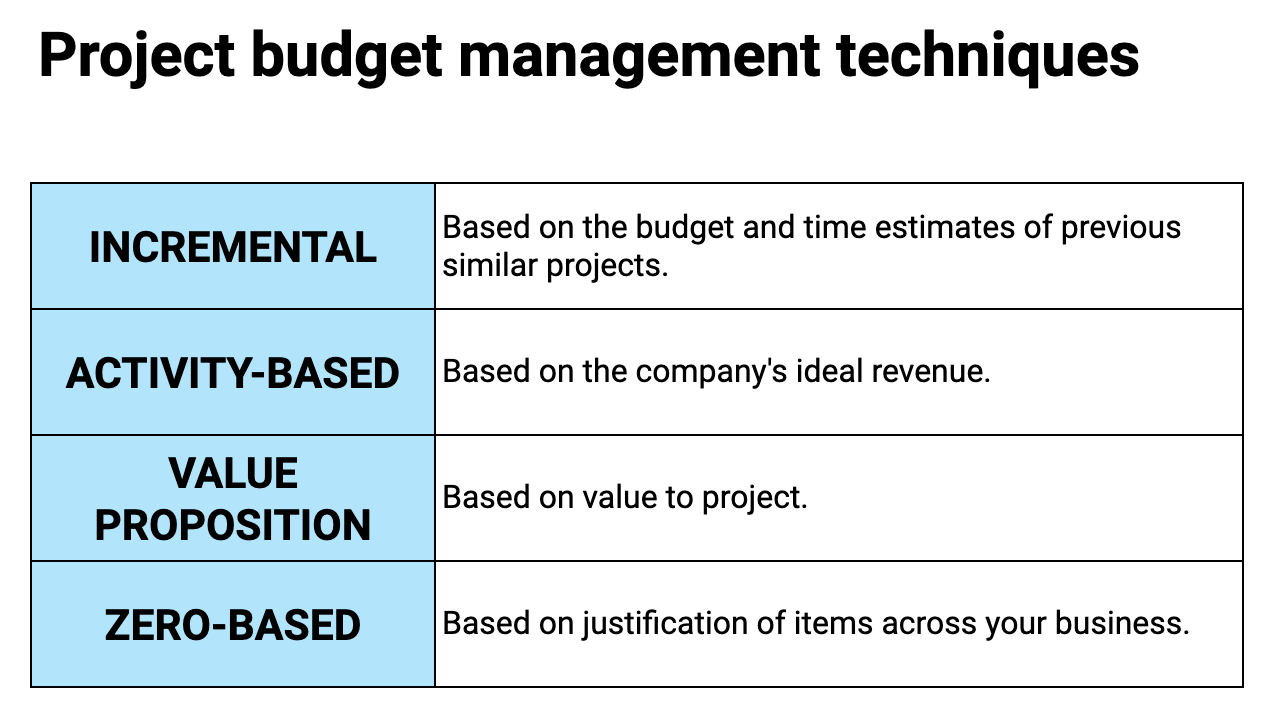
To learn more about the best ways to manage all costs related to a project budget, take a look at these budget cost management techniques.
Budget cost management techniques
In order to make sure you stick to the budget (and cut the costs where you can), you should:
- Train employees to be efficient with their time — Following the right time management tips and increasing the right time management skills will improve your team’s performance, and reduce the risk of a project falling through, which will, in turn, help you save costs.
- Make use of the latest technology — Apart from a project management tool, try introducing other business tools to help automate employees’ work in a cost-effective manner.
- Outsource tasks — Hiring a reputable professional from outside the company to handle a portion of your work (business-related or project-specific work) will help you cut costs.
- Cut down your overhead expenses — Insurance is a non-negotiable overhead expense, but there are some overhead expenses you could work (and live) without. Examples include a stylish office in the city center for your freelance work or fashionable but otherwise less than useful utilities. Cut what you can to make the most of your budget.
The importance of cost management in projects and the listed cost management techniques is almost self-explanatory — when you aim to manage your costs to adhere to the set project budget, you’re essentially letting the set budget guide your decisions.
If you don’t aim to manage your project costs, they’ll likely spiral out of control, and your entire project might fall apart due to faulty management.
Track productivity with Clockify
What are the main goals of project cost management?
The benefits of proper project cost management stem from the main goals of project cost management, which include:
- Focusing on the project delivery based on the value criteria established at the start of the project,
- Monitoring and documenting all transactions, payments, and project-related changes, and
- Making efforts to reduce business costs overall.
In general, the main purpose of proper project cost management is to help project managers successfully complete the project, but also reduce unnecessary project expenses. A project can only be truly successful if you track costs and stay within the project budget.
How to calculate project management costs
When determining project management fees for its major facilities projects, Northwestern University adhered to the following principle — the larger the project, the lower the cost of managing the project compared to the total cost of the project itself.
To see how they calculated their project management expenses according to the size of their projects, take a look at the table below.
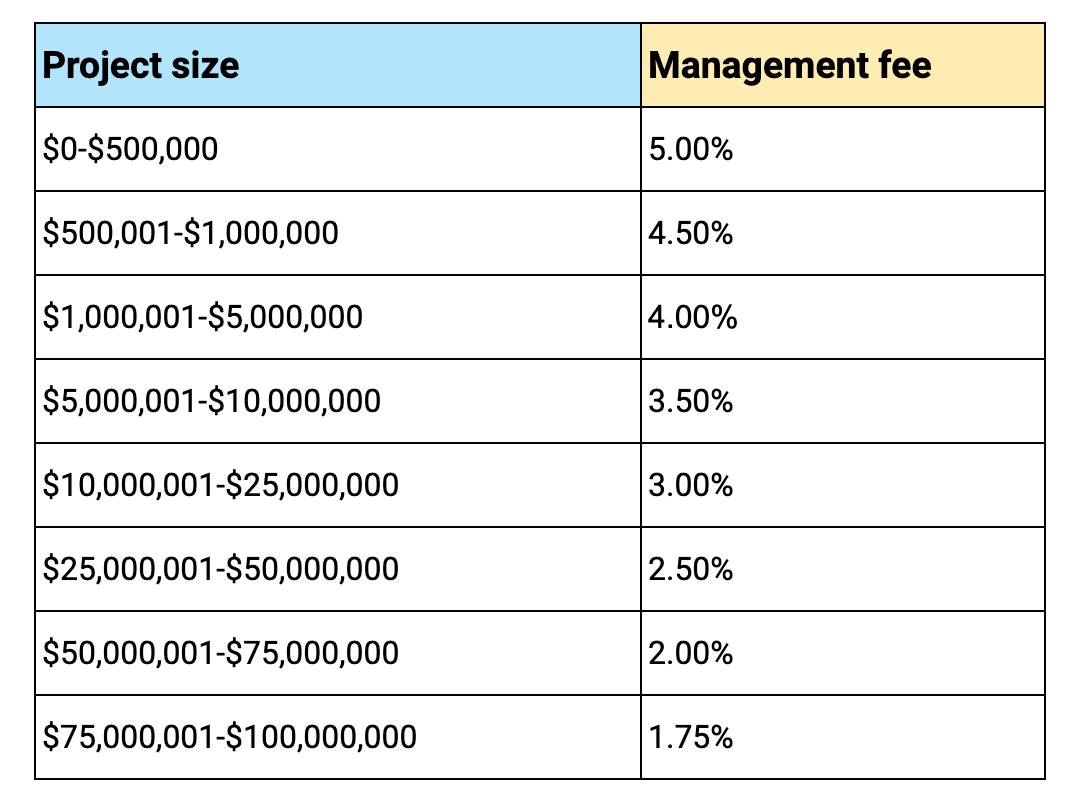
As projects get more expensive and larger, the costs of project management are gradually decreasing — according to a graduated project management fee system they use.
Their fee is based on the project budget that was determined at the beginning of the project itself, and it should also remain the same throughout the duration of the said project.
In essence, your project management costs will depend on your project size, but they will also depend on the price of the project management software you choose to use, which also has to be included in the budget.
What are the 4 steps in project cost management?
To manage your project costs in the best possible way, follow these 4 simple steps:
- Plan the resources,
- Estimate the cost,
- Determine the cost budget, and
- Control the costs.
Step #1: Plan the resources
Resource planning includes reviewing the project scope and then figuring out future resources — these resources are necessary to complete the project. Project scope is a project outline that determines all aspects of the work that needs to be done in order to complete the project.
Resources for the project can include:
- People that are needed to execute the project,
- Certification,
- Equipment and tools, and
- The time needed for each task.
Everything that enables you to complete the project successfully is considered a resource.
To create a comprehensive resource plan, you have to define:
- How many people will be needed for a project,
- What type of experience they need to possess,
- What type of equipment will be needed, and
- What the exact timelines for each of the activities are.
However, regardless of the effort you put into resource planning, there’s always the possibility of some unavoidable obstacles arising. In case this happens, you need to take into account the possibility of certain resources becoming unavailable.
It’s also important to track resource allocation. Tracking resource allocation provides project managers with a clear overview of what needs to be done and helps them facilitate the delegation of tasks.
As we can see in the next step, once we have a complete inventory of all the resources we need, we’ll be able to estimate the costs.
Step #2: Estimate the cost of resources
As soon as you’re done crafting your resource plan, you’ll need to estimate all the costs for the previously allocated resources.
Determining the cost of each resource and taking variable factors into consideration is vital for every decision-making process that involves supplies, tools, and the overall project budget.
After you’ve gathered all the necessary pricing information, you’ll get an estimated calculation of your expenses.
To make sure you’ve obtained the most accurate numbers, you can:
- Track your project time and expenses,
- Monitor the activities of everyone involved in the project, and
- Get to see where the money is going in real-time.
To learn more about the cost budget, let’s get right to the third step.
Step #3: Determine the cost budget
Determining the cost budget is the core of project cost management.
Simply put, a cost budget is a sum of all the costs needed for all the tasks and milestones that the project aims to fulfill. Knowing your cost budget helps you manage the actual costs compared to the estimated ones.
Determining the cost budget highly depends on the project schedule. Also, being aware of task durations and milestones makes it easier to track project deadlines.
Having a cost budgeting strategy also allows project managers to make more accurate budget estimates for future stages or maybe even prevent overruns.
Step #4: Control the costs
Controlling your costs means keeping an eye on all the costs as the project progresses, and recording them.
This process allows you to take appropriate action when there are certain adjustments, such as changes in the prices of materials or services. Cost control is important because it helps you reduce costs and ensures your project remains profitable.
To take control over the costs in the best possible way, here’s what you should do:
- Ensure the project stays within scope,
- Collaborate with stakeholders,
- Follow the schedule and manage your time, and
- Use project management software.
💡 Clockify Pro Tip
Is it hard for you to choose the right project management app with so many project management apps available? To help you choose the most suitable tool for your needs that’ll actually boost your team’s performance, take a look at our guide:
Frequently asked questions about project cost management
In case you still have your doubts about project cost management, let’s go over some of the frequently asked questions and look into everything you need to know about:
- Project management software, and
- Project cost estimation.
Do you need project management software?
One of the more important project costs in project management is project management software — and one of the more important project management questions revolves around project management software cost.
Of course, the entire purpose of using project management software is to speed up the project management process and make it more:
- Precise,
- Accurate, and
- Cost-effective.
So, by using such software, you’re essentially saving money in the long run.
There are many project management tools available for project planning, but finding the right project management software that’s also easy to use can simplify the process of project tracking.
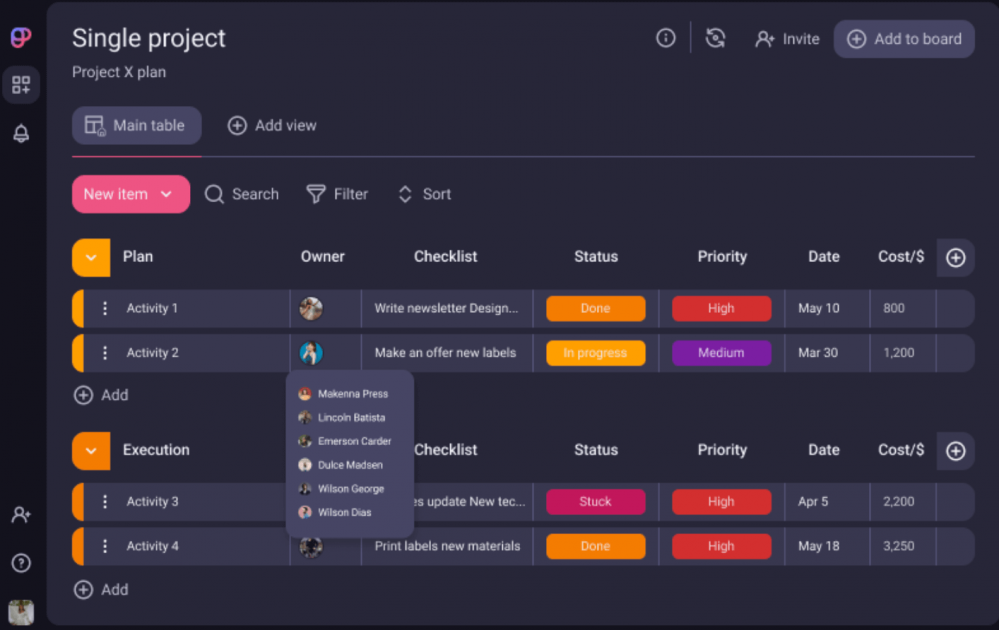
In a project management tool such as Plaky, for example, you can:
- Collaborate with teammates,
- Keep all tasks in one place, and
- Track the progress of your projects.
While you should include the cost of project cost management software in your project planning, there are some other options like Plaky where you can use a large number of features, and all for free.
💡 Clockify Pro Tip
Are you looking for some other useful techniques and tools to help you manage your projects better? Check out our blog post below:
What is project cost estimation?
Project cost estimation is the process of predicting the:
- Cost,
- Quantity, and
- Price of all the resources you need in order to finish the project.
However, considering that the estimation is made before project completion (meaning it cannot account for unexpected expenses and changes), it is often uncertain and serves only as a starting point for setting a project budget and handling cost management.
When estimating your project costs, make sure to cover the following:
- Be precise — Try not to overestimate or underestimate your costs. Make the estimation in relation to what you’re looking to accomplish, your resources, and time period.
- Be accurate — While your consultants, workers, and freelancers are essential for your project’s success, the most important element in your project estimation is the time you’ll spend on it. So, it’s important that you track time on all your projects. This way you’ll get an accurate number of hours for each project type, so it’ll be easier to estimate the time needed to finish projects in the future.
- Understand the project requirements (and limitations) — Be careful not to underestimate the time, the number of team members, and the monetary resources you need overall to bring your project to an end.
Different professionals approach project estimation in various ways, so let’s see what types of cost estimates you can use to manage your project.
Types of cost estimates in project management
There are several effective types of cost estimates in project management:
- Expert judgment — This estimation is most suitable for seasoned professionals as it is based on the previous knowledge and experience of the estimator.
- Cost of quality — This estimation is based on the money spent to manage potential failures and prevent poor project quality. It helps you minimize losses and analyze where you can save money.
- Vendor bid analysis — This estimation is mainly used at public project tenders as it requires you to analyze your competition and guess their bids before making your own.
- Using a project estimation software — This estimation relies on numbers provided by a specialized project estimation software.
- Reserve analysis — This estimation is used to accommodate potential project risks and the reserve resources that need to be secured to accommodate said risks.
- Three-point estimates — This estimation includes the average estimation of the most likely estimation (A), an optimistic estimation (B), and a pessimistic estimation (C). For example: A = $60,000, B = $55,000, C = $80,000. According to the formula, (B + 4A + C)/6, the three-point estimate for the example estimates is $62,000.
- Analogous estimating — This estimation is based on data compiled from previous similar projects. It is usually used in the early stages of a new project.
- Parametric estimating — This technique is similar to the analogous estimating technique, the difference being that the historical data used is based on the relationship between various project variables.
- Bottom-up estimating — This estimation is calculated by comparing the current project with the work packages you’ve already established. After that, you make your estimate for the current project.
How best to estimate a project — example
We’ll show you how to estimate a project through the project cost estimation example. This example takes into account:
- The professionals working on the project,
- Their hourly rates,
- The materials they use, as well as
- The time they need to finish specific tasks.
Here’s what you need to do if you want to estimate your project:
- List all professionals,
- List their respective hourly rates,
- List all the physical resources you’ll need, including all equipment and materials,
- Make an estimation of the time you’ll need to finish the project, and
- Calculate the final price.
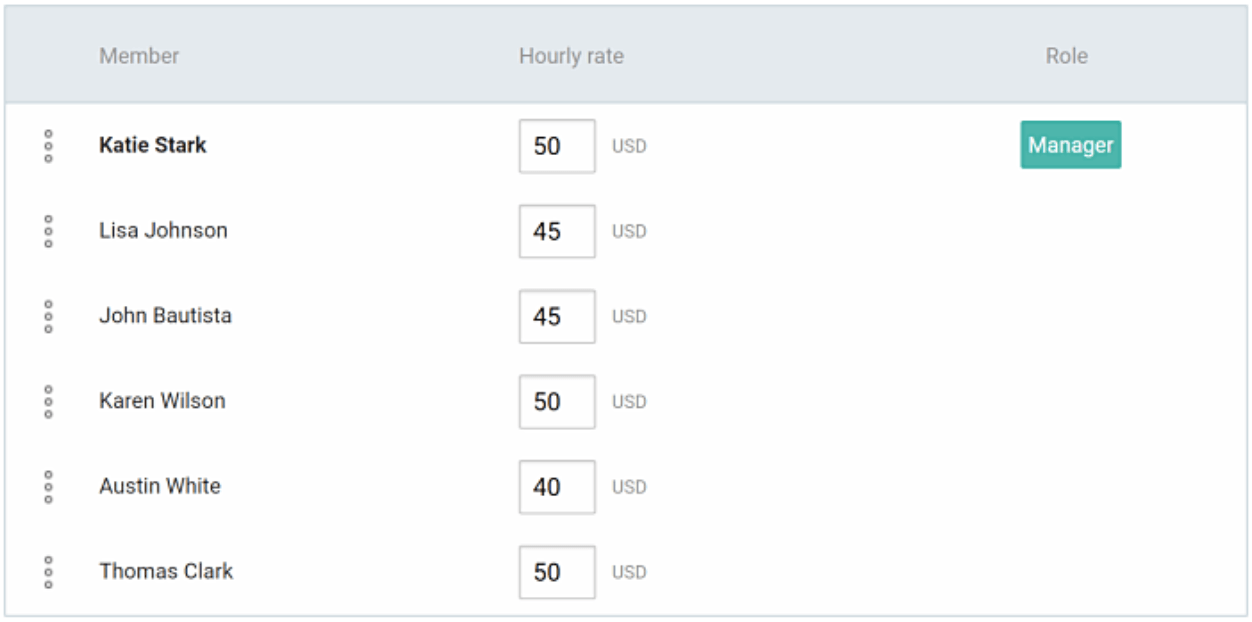
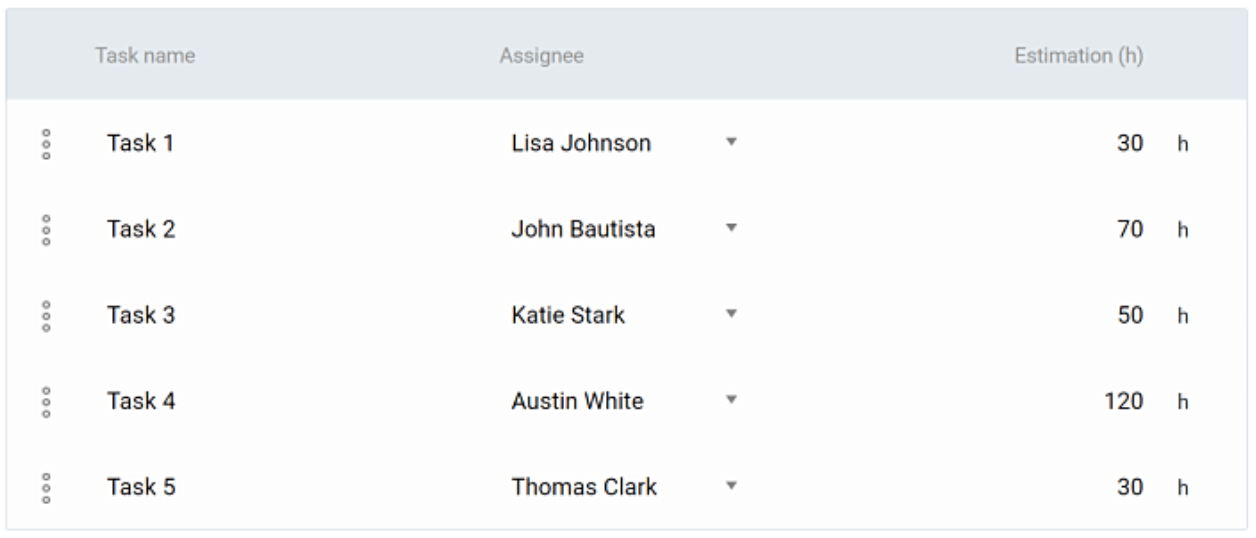
Now you’ve estimated that your team members will spend 300 hours in total on the project-related tasks they were assigned to — more specifically:
- Lisa Johnson (hourly rate: $45) will spend 30h on Task 1
- John Bautista (hourly rate: $45) will spend 70h on Task 2
- Katie Stark (hourly rate: $50) will spend 50h on Task 3
- Austin White (hourly rate: $40) will spend 120h on Task 4
- Thomas Clark (hourly rate: $50) will spend 30h on Task 5
Here’s the formula for the total 300 hours estimated:
Hourly rate x the time spent working (for each employee)
Here is what the equation looks like:
$45 x 30 + $45 x 70 + $50 x 50 + $40 x 120 + $50 x 30 = $13,300
As we mentioned, apart from including your employees, you also need to take into account the clean costs of your materials and equipment. When it comes to materials, you’ll have to include the number of units but also the price per unit.
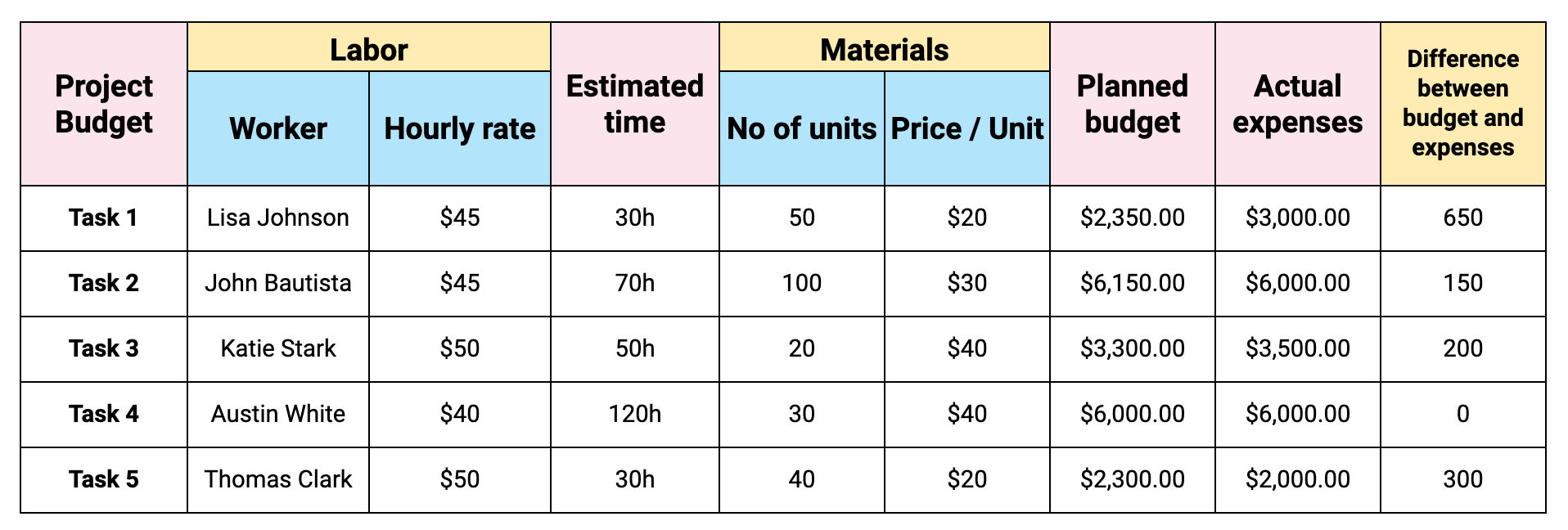
Moreover, when you compare your planned budget with your actual expenses, you’ll see the difference between those two.
Finally, if you track your progress, you’ll be able to change your schedule to allow more time for certain tasks and track when the planned budget is about to hit the limit.
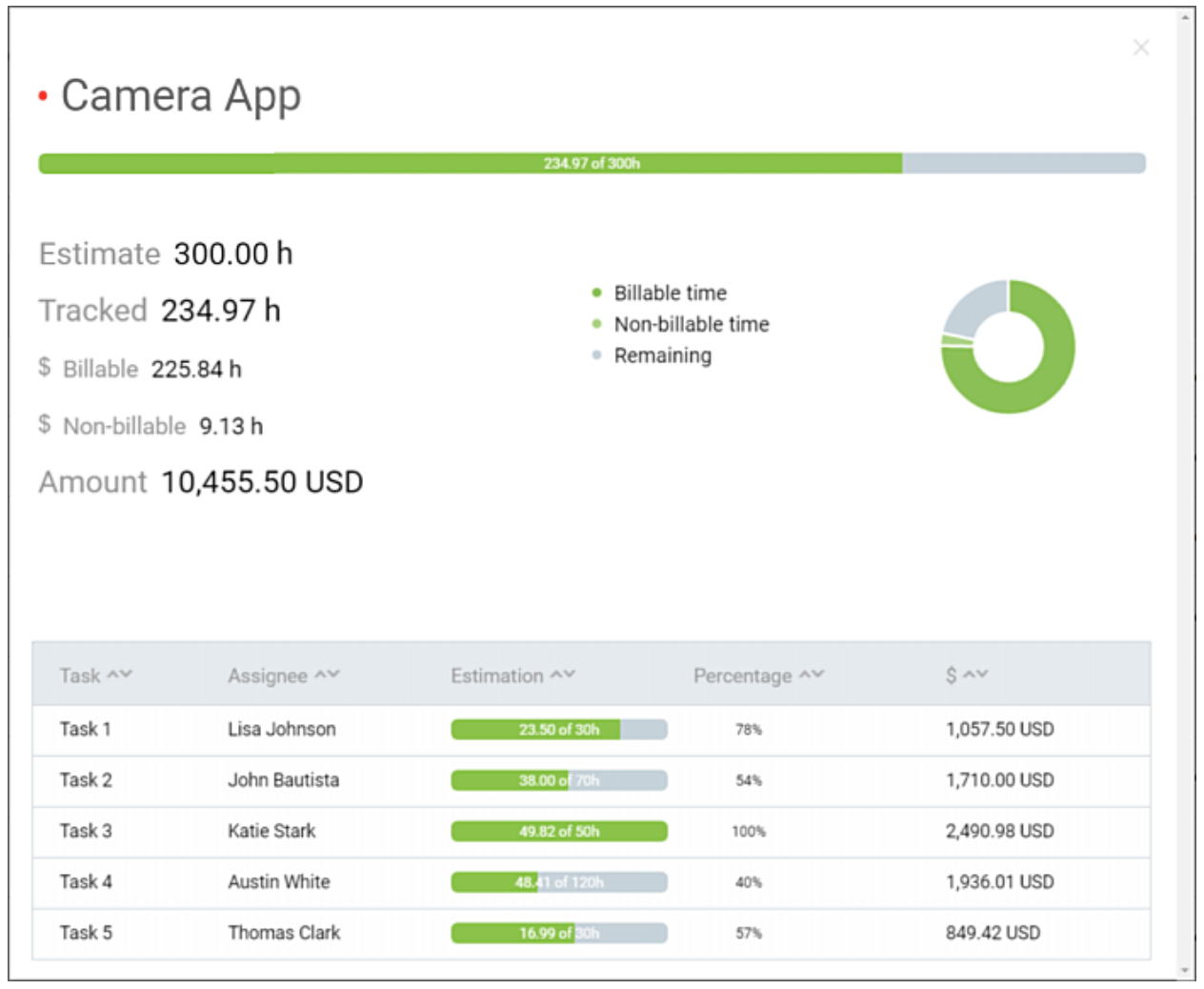
Use Clockify to track budgets and set time estimates
Tracking your time and regularly monitoring budgets can significantly contribute to effective project cost management.
But you probably knew that already.
So, what are you missing?
Well, there’s a way you can keep tabs on your budget by using project-tracking software like Clockify.
With this productivity powerhouse under your belt, you can easily set project budget by following these steps:
- Go to one of your project’s settings tab,
- Select Project budget under Estimate, and
- Insert your cost estimate into the Manual space.
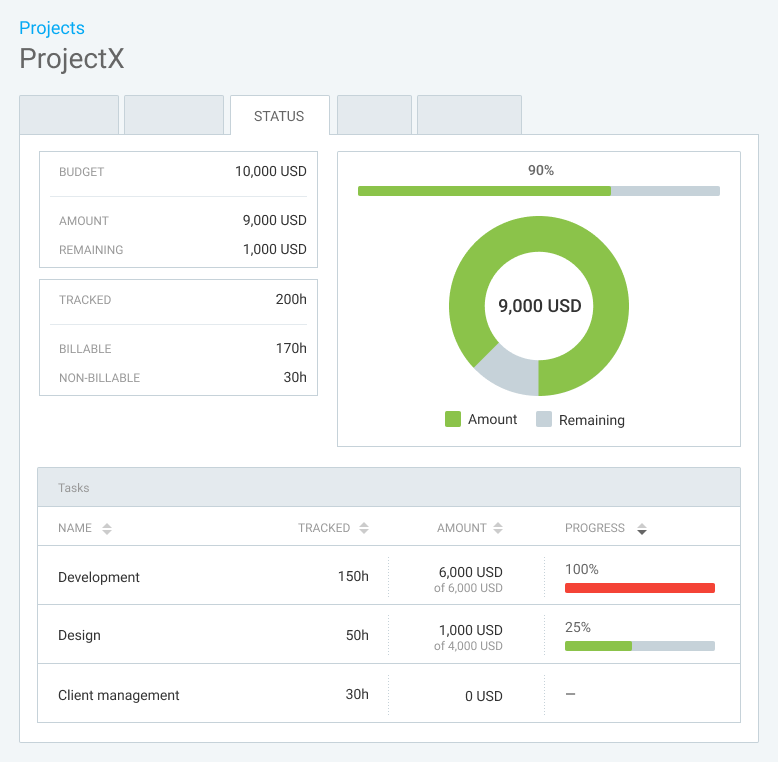
So, if the project runs into the risk of exceeding its budget, you can take proactive measures to address the issue.
Equally important, you can set up alerts when you’re close to going over budget.

You just need to visit your Workspace settings, choose Alerts, and add the criteria you like for getting a notification from Clockify. It can be something like: “If Project X reaches 90% of estimate, alert Workspace admin.”
Speaking of estimates, did you know you can even set up time estimates for all your projects?
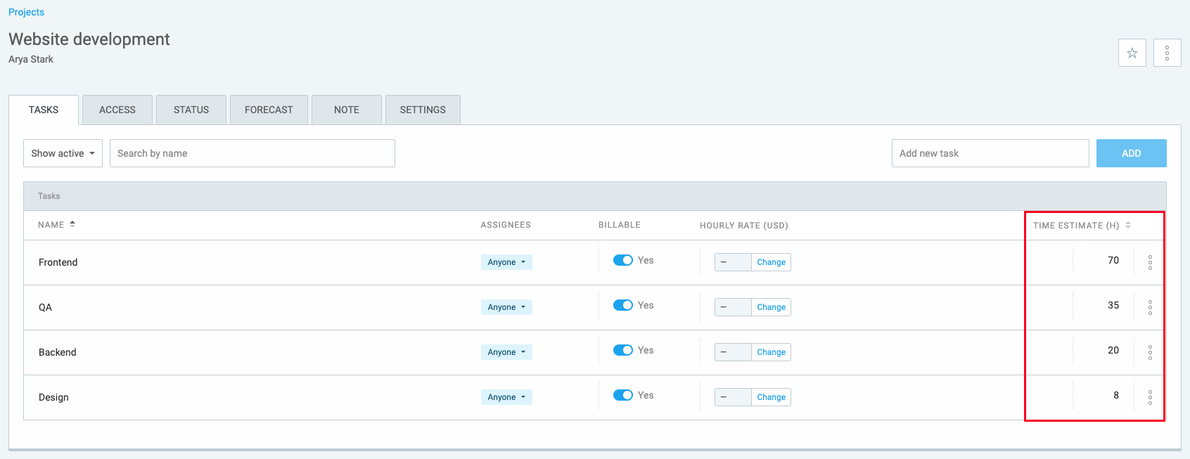
Estimates are useful because they help you determine whether to charge more (or less) for your projects. For example, as soon as you compare estimated versus tracked time you spent on a particular project, you can get a better idea of how long a project of that sort takes to implement. As a result, you’ll be better able to:
- Create better quotes for future clients, and
- Set more accurate budgets.
To get your team and projects up to speed even faster, you can now get Clockify paired with 2 more productivity tools within a special productivity bundle.



